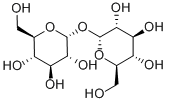Trehalose
| CAS No. | 99-20-7 | Cat. No. | BCP07695 |
| Name | Trehalose | ||
| Synonyms | D-Trehalose; | ||
| Formula | C12H22O11 | M. Wt | 342.3 |
| Description | Trehalose, also known as mycose, is a 1-alpha (disaccharide) sugar found extensively but not abundantly in nature. It is thought to be implicated in anhydrobiosis - the ability of plants and animals to withstand prolonged periods of desiccation. The sugar is thought to form a gel phase as cells dehydrate, which prevents disruption of internal cell organelles by effectively splinting them in position. Rehydration then allows normal cellular activity to be resumed without the major, generally lethal damage that would normally follow a dehydration/reyhdration cycle. Trehalose is a non-reducing sugar formed from two glucose units joined by a 1-1 alpha bond giving it the name of alpha-D-glucopyranoglucopyranosyl-1, 1-alpha-D-glucopyranoside. The bonding makes trehalose very resistant to acid hydrolysis, and therefore stable in solution at high temperatures even under acidic conditions. The bonding also keeps non-reducing sugars in closed-ring form, such that the aldehyde or ketone end-groups do not bind to the lysine or arginine residues of proteins (a process called glycation). The enzyme trehalase, present but not abundant in most people, breaks it into two glucose molecules, which can then be readily absorbed in the gut. Trehalose is an important components of insects circulating fluid. It acts as a storage form of insect circulating fluid and it is important in respiration. |
Structure

Part data of this page collected from the open network resources, so Biochempartner can not guarantee its accuracy.
For product details of different batches, please contact our Customer
- Service & Tech Support:orders@biochempartner.com
- Website:www.biochempartner.com
Products are for research use only and not for human use. We do not sell to patients.
